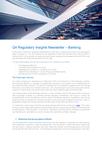
Banking - Q4 2022
There were several regulatory developments in Q4 2022, including the launch of the consultation paper on Basel 3.1. This was followed by the publication of the 2023 priorities letter from the PRA in January 2023. In this update, we have discussed the key regulatory developments from Q4 2022, and also discussed the PRA priorities letter from Q1 2023.
The key developments that we have discussed in this update are as follows:
- The Edinburgh Reforms – where there are three developments of note: (a) review of ringfencing regime, where some firms could potentially be exempted from the requirements; (b) review of SM(C)R, where some elements of accountability are expected to be relaxed; and (c) changes to the PRA and FCA’s regulatory remit.
- The PRA’s future approach to policy – where the Deputy Governor for Prudential Policy at the Bank of England talks about a more responsive approach to policymaking; a dedicated drive to bolster international competitiveness by adjusting the burden of UK regulations; and the need to balance of regulation to benefit innovation. The note lays the groundwork for future regulations and regulatory changes.
- Implementation of Basel 3.1 standards (CP 16/22) – where the PRA consults on a number of areas including the standardised approach for measuring credit risk, changes to the IRB approach, approach to credit mitigation techniques, introduction of an “Output Floor” providing a limit on the extent to which firms using IRB can lower RWAs, a new approach to operational risk, and removal of internal models for CVA risk.
- Implications of the Basel 3.1 on the Strong and Simple regime – where the PRA hints on how the Basel 3.1 implementation might influence the roll out of their new initiative on the Strong and Simple Regime which is aimed at small to medium sized institutions.
- Banking priorities for 2023 – published in Q1 2023 – sets out priorities for branches and subsidiaries that operate in the UK. These priorities include risk management and governance; operational risk and resilience; and data management.
For a more comprehensive review on this topic, please click on the pdf below:





